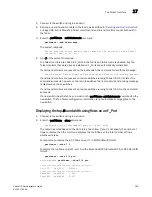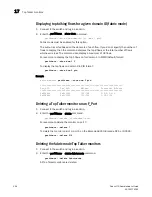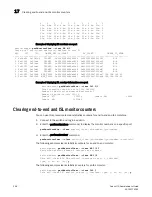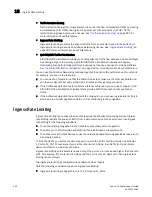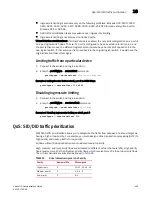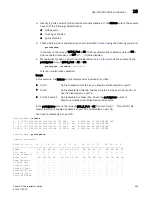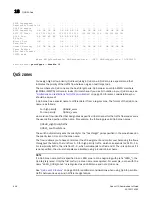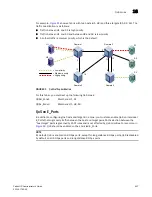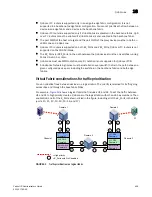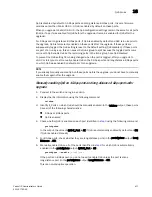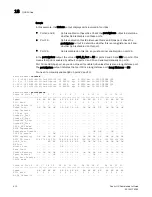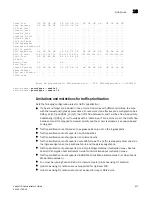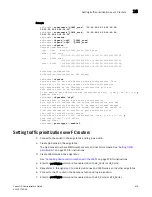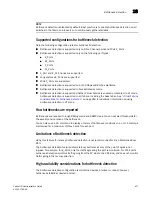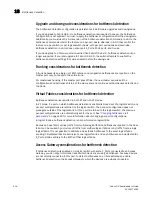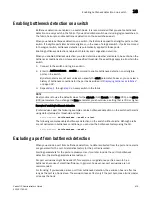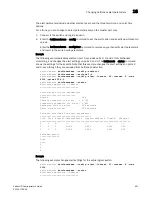
408
Fabric OS Administrator’s Guide
53-1001763-02
QoS zones
18
FIGURE 62
QoS with E_Ports enabled
You need to enable QoS on the E_Ports on both ISLs between Domain 3 and Domain 4 because
either path might be selected to carry the traffic.
You do
not
need to enable QoS on the E_Ports on the ISLs between Domain 1 and Domain 2 and
between Domain 2 and Domain 3, because these are not the shortest paths between the hosts
and the targets. However, if the ISL between Domain 1 and Domain 3 is broken, then the path
through Domain 2 would be used.
To guarantee traffic priority, you should enable QoS on all possible E_Ports. Alternatively, you could
use a TI zone to limit the E_Ports that carry the traffic between a “host,target” pair and enable QoS
on only those E_Ports.
If QoS is not enabled on an E_Port, the traffic prioritization stops at that point. For example, in
Figure 62
if you disabled QoS on E_Ports “3,12” and “3,13” then the traffic from H1 and H2 to S3
would be low priority from the hosts to Domain 3, but would switch to the default (medium) priority
from Domain 3 to the target S3.
QoS over FC routers
QoS over FCR is QoS traffic prioritization between devices in edge fabrics over an FC router. See
Chapter 21, “Using the FC-FC Routing Service,”
for information about FC routers, phantom
switches, and the FC-FC Routing Service.
To establish QoS over FC routers, you must do the following:
•
Define QoS zones in each edge fabric.
•
Define LSAN zones in each edge fabric.
•
Enable QoS on the E_Ports (or VE_Ports) in each edge fabric.
•
Enable QoS on the EX_Ports (or VEX_Ports) in the backbone fabric.
See
“Setting traffic prioritization over FC routers”
on page 415 for detailed instructions.
Following are requirements for establishing QoS over FCR:
•
QoS over FC routers is supported in Brocade native mode only. It is not supported in
interopmode 2 or interopmode 3.
7
12
3
14
15
16
8
13
Domain 1
Domain 3
Domain 4
Domain 2
H1
1
9
S3
S2
S1
H2
= High priority
= Medium priority
= Low priority
= E_Ports with
QoS enabled
Summary of Contents for 53-1001763-02
Page 1: ...53 1001763 02 13 September 2010 Fabric OS Administrator s Guide Supporting Fabric OS v6 4 0 ...
Page 4: ...iv Fabric OS Administrator s Guide 53 1001763 02 ...
Page 24: ...xxiv Fabric OS Administrator s Guide 53 1001763 02 ...
Page 28: ...xxviii Fabric OS Administrator s Guide 53 1001763 02 ...
Page 32: ...xxxii Fabric OS Administrator s Guide 53 1001763 02 ...
Page 40: ...xl Fabric OS Administrator s Guide 53 1001763 02 ...
Page 42: ...2 Fabric OS Administrator s Guide 53 1001763 02 ...
Page 54: ...14 Fabric OS Administrator s Guide 53 1001763 02 High availability of daemon processes 1 ...
Page 74: ...34 Fabric OS Administrator s Guide 53 1001763 02 Basic connections 2 ...
Page 102: ...62 Fabric OS Administrator s Guide 53 1001763 02 Audit log configuration 3 ...
Page 214: ...174 Fabric OS Administrator s Guide 53 1001763 02 Management interface security 7 ...
Page 228: ...188 Fabric OS Administrator s Guide 53 1001763 02 Brocade configuration form 8 ...
Page 276: ...236 Fabric OS Administrator s Guide 53 1001763 02 Creating a logical fabric using XISLs 10 ...
Page 404: ...364 Fabric OS Administrator s Guide 53 1001763 02 ...
Page 440: ...400 Fabric OS Administrator s Guide 53 1001763 02 Performance data collection 17 ...
Page 480: ...440 Fabric OS Administrator s Guide 53 1001763 02 F_Port masterless trunking 19 ...
Page 494: ...454 Fabric OS Administrator s Guide 53 1001763 02 Buffer credit recovery 20 ...
Page 574: ...534 Fabric OS Administrator s Guide 53 1001763 02 Hexadecimal overview E ...


